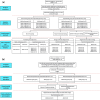Changes in Disc Status and Condylar Regeneration After Intracapsular Condylar Fractures in Rabbits
- PMID: 39737831
- PMCID: PMC12291424
- DOI: 10.1111/odi.15238
Changes in Disc Status and Condylar Regeneration After Intracapsular Condylar Fractures in Rabbits
Abstract
Background: The treatment procedure for intracapsular condylar fractures (ICF) is still being debated. The temporomandibular joint (TMJ) disc is a key factor for treating ICF. The study aims to investigate the changes in TMJ disc status and condylar cartilage regeneration following ICF in a rabbit model, to assist in planning treatment.
Methods: Adolescent and adult rabbits received surgery on the left TMJs: (1) ICF with anterior disc displacement, (2) ICF with the removal of the ICF segment and disc. The animals were euthanized immediately, and at 4, 8, and 12 weeks after surgery. Their left TMJs were collected for histological, SOX 9 immunohistochemical, and micro-CT analyses.
Results: All 36 TMJs (100%) showed anterior disc displacement at 4, 8, and 12 weeks after surgery. Also, condylar cartilage regeneration was observed in all 36 joints. Notably, partial regeneration of condylar cartilage was noted at 4 weeks after removal of the disc and ICF fractured segment in both adolescent and adult groups.
Conclusion: Anterior displaced disc after ICF in adolescent and adult rabbits exhibited sustained disc displacement without therapeutic intervention. TMJ disc and associated attachment are crucial in the condylar cartilage regeneration after ICF.
Keywords: anterior disc displacement; cartilage; intracapsular condylar fracture; rabbit; temporomandibular joint.
© 2024 The Author(s). Oral Diseases published by John Wiley & Sons Ltd.
Conflict of interest statement
The authors declare no conflicts of interest.
Figures










Similar articles
-
The relationship between the articular disc in magnetic resonance imaging and the condyle in cone beam computed tomography: A retrospective study.J Stomatol Oral Maxillofac Surg. 2024 Sep;125(12 Suppl 2):101940. doi: 10.1016/j.jormas.2024.101940. Epub 2024 Jun 8. J Stomatol Oral Maxillofac Surg. 2024. PMID: 38857693
-
[Clinical analysis of changes in the position of the condyle and temporomandibular joint after repair of mandibular defects].Hua Xi Kou Qiang Yi Xue Za Zhi. 2025 Jun 1;43(3):422-430. doi: 10.7518/hxkq.2025.2024337. Hua Xi Kou Qiang Yi Xue Za Zhi. 2025. PMID: 40523823 Free PMC article. Chinese.
-
Effect of sagittal position of the articular disc on condylar bone remodeling after disc repositioning surgeries in adolescents: A retrospective cohort study.J Craniomaxillofac Surg. 2025 Sep;53(9):1626-1637. doi: 10.1016/j.jcms.2025.07.001. Epub 2025 Jul 16. J Craniomaxillofac Surg. 2025. PMID: 40675877
-
Evaluating changes in the condylar head after orthognathic surgery with or without articular disc repositioning: a systematic review.Br J Oral Maxillofac Surg. 2024 May;62(4):340-348. doi: 10.1016/j.bjoms.2024.01.004. Epub 2024 Jan 14. Br J Oral Maxillofac Surg. 2024. PMID: 38521741
-
Impact of treatment modalities on condylar and jaw growth in adolescents with anterior disc displacement of the temporomandibular joint: a systematic review and meta-analysis.J Craniomaxillofac Surg. 2025 Aug;53(8):1246-1254. doi: 10.1016/j.jcms.2025.04.026. Epub 2025 May 19. J Craniomaxillofac Surg. 2025. PMID: 40393844
Cited by
-
Etiopathogenesis of Oral Lichen Planus: A Review.Head Neck Pathol. 2025 Jun 6;19(1):73. doi: 10.1007/s12105-025-01807-w. Head Neck Pathol. 2025. PMID: 40478312 Review.
-
The heterogeneous roles of neutrophils in gastric cancer: scaffold or target?Cell Mol Biol Lett. 2025 Jun 16;30(1):71. doi: 10.1186/s11658-025-00744-4. Cell Mol Biol Lett. 2025. PMID: 40524157 Free PMC article. Review.
References
-
- Cai, B. L. , Ren R., Yu H. B., Liu P. C., Shen S. G. F., and Shi J.. 2018. “Do Open Reduction and Internal Fixation With Articular Disc Anatomical Reduction and Rigid Anchorage Manifest a Promising Prospect in the Treatment of Intracapsular Fractures?” Journal of Oral and Maxillofacial Surgery 76, no. 5: 1026–1035. 10.1016/j.joms.2017.12.015. - DOI - PubMed
MeSH terms
Substances
Grants and funding
LinkOut - more resources
Full Text Sources
Miscellaneous

